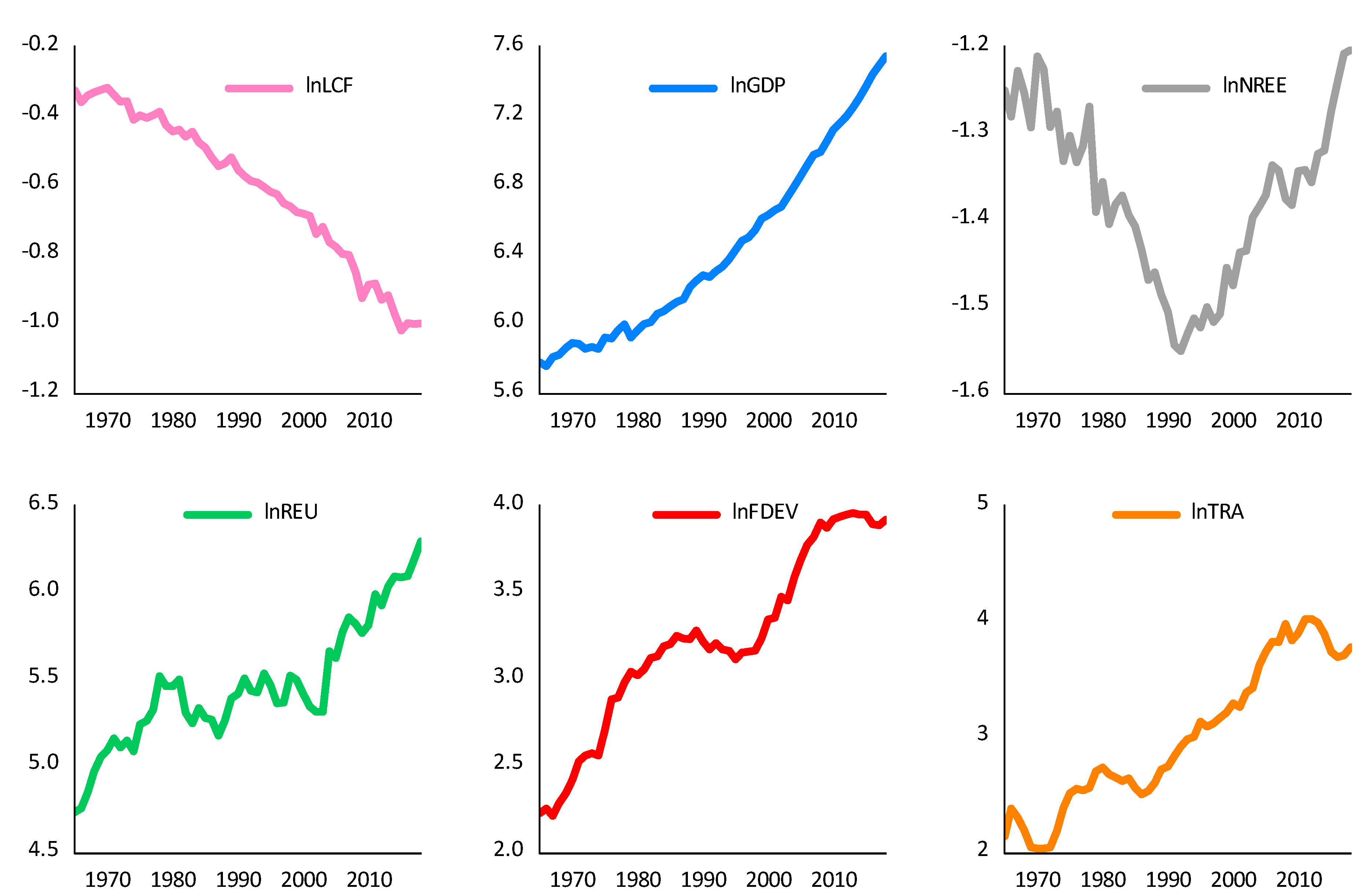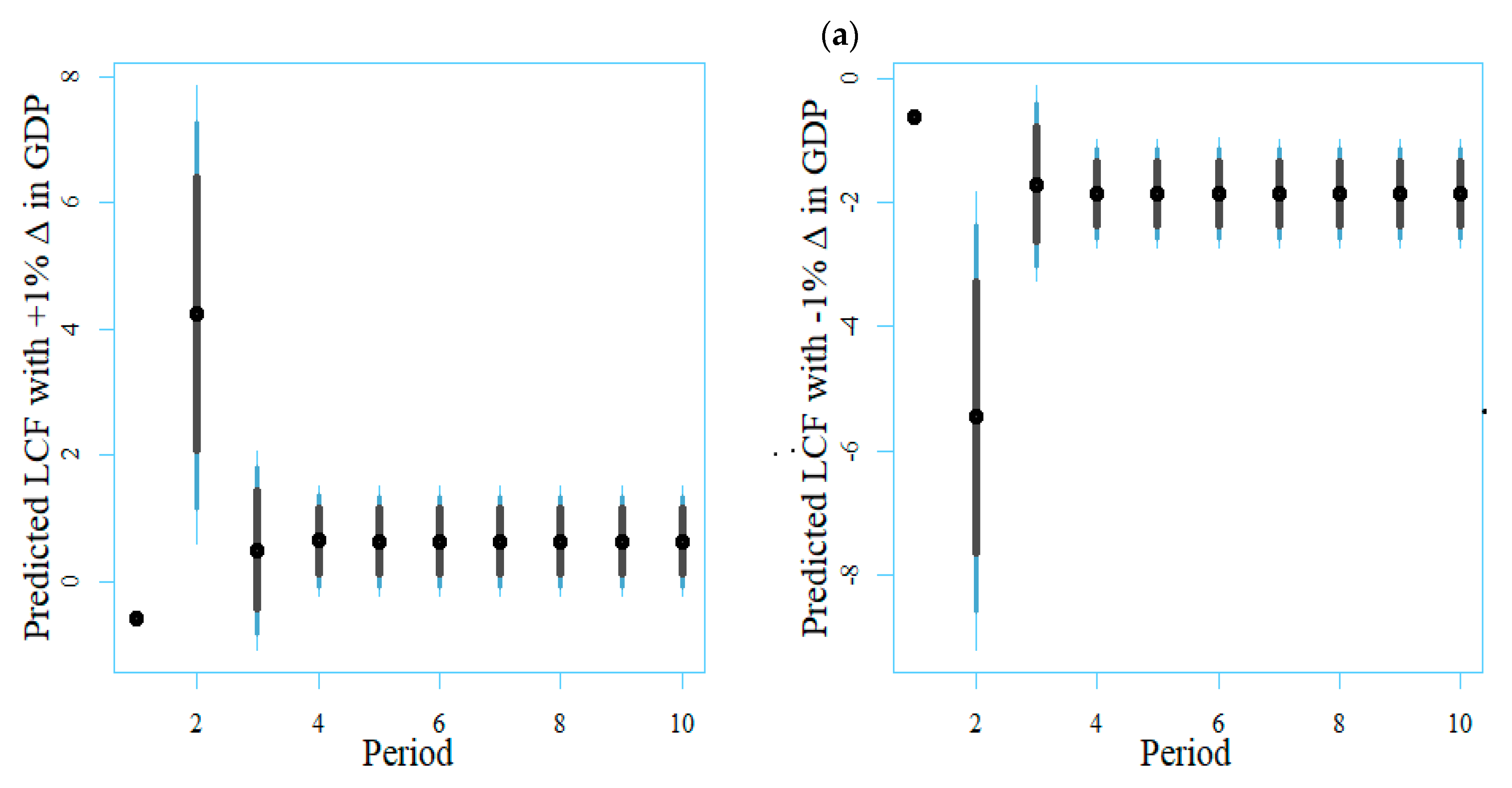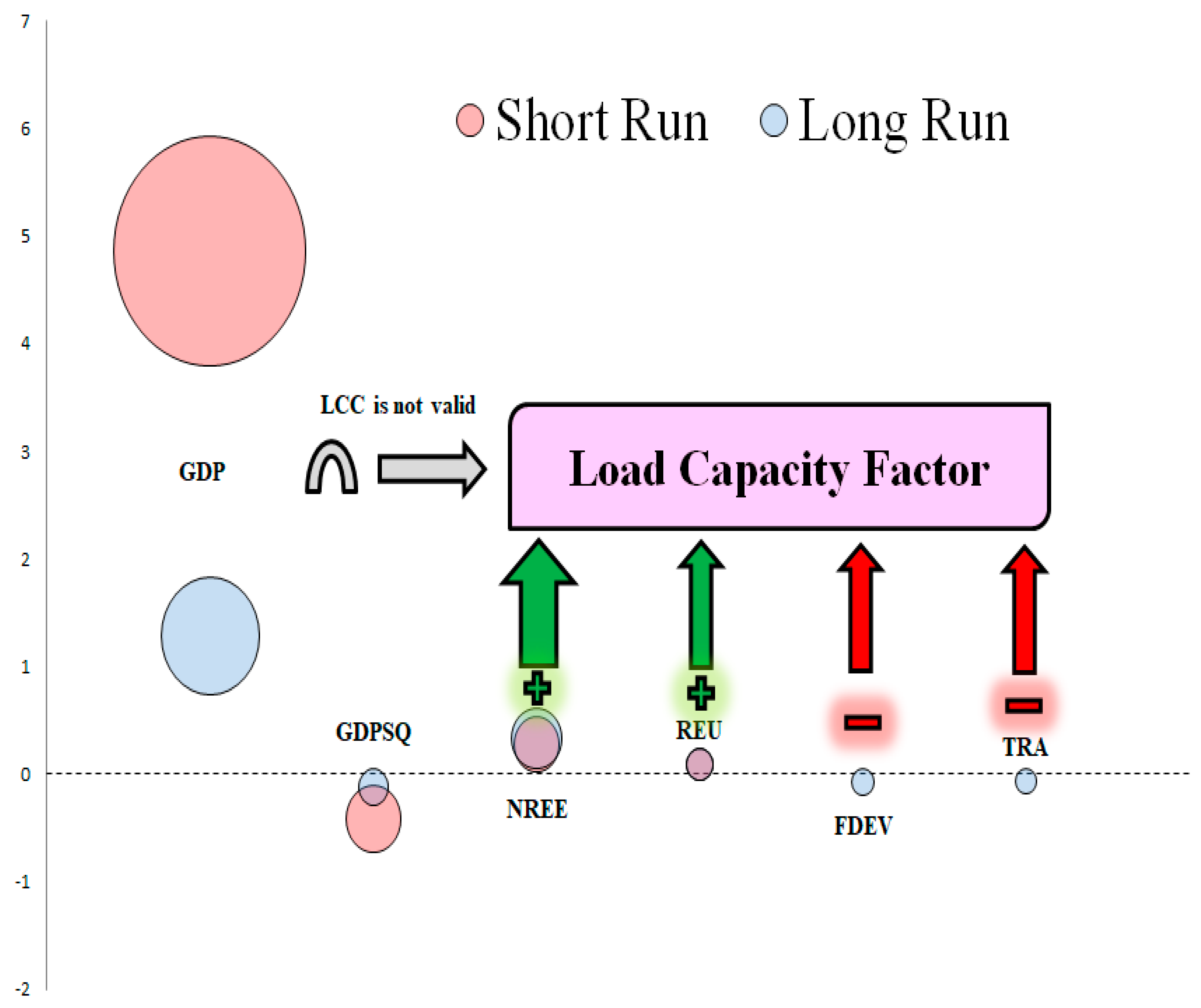Role of Non-Renewable Energy Efficiency and Renewable Energy in Driving Environmental Sustainability in India: Evidence from the Load Capacity Factor Hypothesis
Abstract
1. Introduction
2. Review of Related Literature
2.1. LCF and Energy Mix
2.2. Trade, Financial Development, and LCF
3. Data Description and Modeling Techniques
3.1. Description of Data
3.2. Model & Methodology
4. Empirical Results
Discussion of Findings
5. Conclusions and Policy Recommendations
Policy Recommendation
Author Contributions
Funding
Data Availability Statement
Conflicts of Interest
References
- GFN. Available online: https://www.footprintnetwork.org/ (accessed on 24 December 2022).
- Minitry of Commerce and Industry. 2022. Available online: https://tradestat.commerce.gov.in/eidb/default.asp (accessed on 4 January 2023).
- World Bank. Trade (% of GDP)–India. 2022. Available online: https://data.worldbank.org/indicator/NE.TRD.GNFS.ZS?locations=IN. (accessed on 4 January 2023).
- Rahman, M.M. Exploring the effects of economic growth, population density and international trade on energy consumption and environmental quality in India. Int. J. Energy Sect. Manag. 2020, 14, 1177–1203. [Google Scholar] [CrossRef]
- Ahmad, W.; Ozturk, I.; Majeed, M.T. Asymmetric impact of disaggregate energy consumption on environmental quality for Pakistan, Bangladesh and India. Int. J. Ambient. Energy 2022, 43, 8248–8258. [Google Scholar] [CrossRef]
- Udemba, E.N. Mediation of foreign direct investment and agriculture towards ecological footprint: A shift from single perspective to a more inclusive perspective for India. Environ. Sci. Pollut. Res. 2020, 27, 26817–26834. [Google Scholar] [CrossRef] [PubMed]
- Zoaka, J.D.; Ekwueme, D.C.; Güngör, H.; Alola, A.A. Will financial development and clean energy utilization rejuvenate the environment in BRICS economies? Bus. Strategy Environ. 2022, 31, 2156–2170. [Google Scholar] [CrossRef]
- Dietz, T.; Rosa, E.A. Effects of population and affluence on CO2 emissions. Proc. Natl. Acad. Sci. USA 1997, 94, 175–179. [Google Scholar] [CrossRef]
- York, R.; Rosa, E.A.; Dietz, T. STIRPAT, IPAT and ImPACT: Analytic tools for unpacking the driving forces of environmental impacts. Ecol. Econ. 2003, 46, 351–365. [Google Scholar] [CrossRef]
- Kuznets, S. Economic growth and income inequality. In The Gap Between Rich and Poor; Routledge: Abingdon-on-Thames, UK, 2019; pp. 25–37. [Google Scholar]
- Pata, U.K.; Samour, A. Do renewable and nuclear energy enhance environmental quality in France? A new EKC approach with the load capacity factor. Prog. Nucl. Energy 2022, 149, 104249. [Google Scholar] [CrossRef]
- Pata, U.K.; Kartal, M.T. Impact of nuclear and renewable energy sources on environment quality: Testing the EKC and LCC hypotheses for South Korea. Nucl. Eng. Technol. 2023, 55, 587–594. [Google Scholar] [CrossRef]
- Pata, U.K.; Balsalobre-Lorente, D. Exploring the impact of tourism and energy consumption on the load capacity factor in Turkey: A novel dynamic ARDL approach. Environ. Sci. Pollut. Res. 2022, 29, 13491–13503. [Google Scholar] [CrossRef] [PubMed]
- Pata, U.K.; Tanriover, B. Is the Load Capacity Curve Hypothesis Valid for the Top Ten Tourism Destinations? Sustainability 2023, 15, 960. [Google Scholar] [CrossRef]
- Akadiri, S.S.; Adebayo, T.S.; Riti, J.S.; Awosusi, A.A.; Inusa, E.M. The effect of financial globalization and natural resource rent on load capacity factor in India: An analysis using the dual adjustment approach. Environ. Sci. Pollut. Res. 2022, 29, 89045–89062. [Google Scholar] [CrossRef] [PubMed]
- Xu, D.; Salem, S.; Awosusi, A.A.; Abdurakhmanova, G.; Altuntaş, M.; Oluwajana, D.; Kirikkaleli, D.; Ojekemi, O. Load Capacity Factor and Financial Globalization in Brazil: The Role of Renewable Energy and Urbanization. Front. Environ. Sci. 2022, 9. [Google Scholar] [CrossRef]
- Huilan, W.; Akadiri, S.S.; Haouas, I.; Awosusi, A.A.; Odu, A.T. Impact of trade liberalization and renewable energy on load capacity factor: Evidence from novel dual adjustment approach. Energy Environ. 2022. [Google Scholar] [CrossRef]
- Akhayere, E.; Kartal, M.T.; Adebayo, T.S.; Kavaz, D. Role of energy consumption and trade openness towards environmental sustainability in Turkey. Environ. Sci. Pollut. Res. 2022, 30, 21156–21168. [Google Scholar] [CrossRef]
- OWD. Our World in Data. 2022. Available online: https://ourworldindata.org/ (accessed on 24 December 2022).
- Usman, O.; Alola, A.A.; Sarkodie, S.A. Assessment of the role of renewable energy consumption and trade policy on environmental degradation using innovation accounting: Evidence from the US. Renew. Energy 2020, 150, 266–277. [Google Scholar] [CrossRef]
- Tan, Z.; Koondhar, M.A.; Nawaz, K.; Malik, M.N.; Khan, Z.A.; Koondhar, M.A. Foreign direct investment, financial development, energy consumption, and air quality: A way for carbon neutrality in China. J. Environ. Manag. 2021, 299, 113572. [Google Scholar] [CrossRef]
- Rafindadi, A.A.; Aliyu, I.B.; Usman, O. Revisiting the electricity consumption-led growth hypothesis: Is the rule defied in France? J. Econ. Struct. 2022, 11, 27. [Google Scholar] [CrossRef]
- Xu, B.; Li, S.; Afzal, A.; Mirza, N.; Zhang, M. The impact of financial development on environmental sustainability: A European perspective. Resour. Policy 2022, 78, 102814. [Google Scholar] [CrossRef]
- Koengkan, M. The positive impact of trade openness on consumption of energy: Fresh evidence from Andean community countries. Energy 2018, 158, 936–943. [Google Scholar] [CrossRef]
- Destek, M.A.; Sinha, A. Renewable, non-renewable energy consumption, economic growth, trade openness and ecological footprint: Evidence from organisation for economic Co-operation and development countries. J. Clean. Prod. 2020, 242, 118537. [Google Scholar] [CrossRef]
- Wang, W.; Rehman, M.A.; Fahad, S. The dynamic influence of renewable energy, trade openness, and industrialization on the sustainable environment in G-7 economies. Renew. Energy 2022, 198, 484–491. [Google Scholar] [CrossRef]
- Jarque, C.M.; Bera, A.K. Efficient tests for normality, homoscedasticity and serial independence of regression residuals. Econ. Lett. 1980, 6, 255–259. [Google Scholar] [CrossRef]
- Thadewald, T.; Büning, H. Jarque–Bera Test and its Competitors for Testing Normality–A Power Comparison. J. Appl. Stat. 2007, 34, 87–105. [Google Scholar] [CrossRef]
- Jordan, S.; Philips, A.Q. Cointegration testing and dynamic simulations of autoregressive distributed lag models. Stata J. 2018, 18, 902–923. [Google Scholar] [CrossRef]
- Pesaran, M.H.; Shin, Y.; Smith, R.J. Bounds testing approaches to the analysis of level relationships. J. Appl. Econom. 2001, 16, 289–326. [Google Scholar] [CrossRef]
- Khan, M.K.; Teng, J.Z. The impact of macroeconomic and financial development on carbon dioxide emissions in Pakistan: Evidence with a novel dynamic simulated ARDL approach. Environ. Sci. Pollut. Res. 2020, 27, 39560–39571. [Google Scholar] [CrossRef]
- Nwani, C.; Omoke, P.C. Does bank credit to the private sector promote low-carbon development in Brazil? An extended STIRPAT analysis using dynamic ARDL simulations. Environ. Sci. Pollut. Res. 2020, 27, 31408–31426. [Google Scholar] [CrossRef] [PubMed]
- Usman, O. Modelling the economic and social issues related to environmental quality in Nigeria: The role of economic growth and internal conflict. Environ. Sci. Pollut. Res. 2022, 29, 39209–39227. [Google Scholar] [CrossRef] [PubMed]
- Dickey, D.A.; Fuller, W.A. Distribution of the estimators for autoregressive time series with a unit root. J. Am. Stat. Assoc. 1979, 74, 427–431. [Google Scholar]
- Phillips, P.C.B.; Perron, P. Testing for a unit root in time series regression. Biometrika 1988, 75, 335–346. [Google Scholar] [CrossRef]
- Zivot, E.; Andrews, D.W.K. Further Evidence on the Great Crash, the Oil-Price Shock, and the Unit-Root Hypothesis. J. Bus. Econ. Stat. 1992, 10, 251–270. [Google Scholar]
- Sebri, M.; Ben-Salha, O. On the causal dynamics between economic growth, renewable energy consumption, CO2 emissions and trade openness: Fresh evidence from BRICS countries. Renew. Sustain. Energy Rev. 2014, 39, 14–23. [Google Scholar] [CrossRef]
- Alola, A.A. The trilemma of trade, monetary and immigration policies in the United States: Accounting for environmental sustainability. Sci. Total Environ. 2019, 658, 260–267. [Google Scholar] [CrossRef] [PubMed]
- Umar, M.; Ji, X.; Kirikkaleli, D.; Alola, A.A. The imperativeness of environmental quality in the United States transportation sector amidst biomass-fossil energy consumption and growth. J. Clean. Prod. 2021, 285, 124863. [Google Scholar] [CrossRef]
- Olasehinde-Williams, G.; Olanipekun, I.; Özkan, O. Foreign exchange market response to pandemic-induced fear: Evidence from (a)symmetric wild bootstrap likelihood ratio approach. J. Int. Trade Econ. Dev. 2021, 30, 988–1003. [Google Scholar] [CrossRef]
- Özkan, O.; Çakar, R. Investigation of Momentum and Contrarian Anomalies in the Islamic Stocks: Empirical Evidence from Turkey. Sosyoekonomi 2021, 29, 251–270. [Google Scholar]
- Zhou, R.; Abbasi, K.R.; Salem, S.; Almulhim, A.; Alvarado, R. Do natural resources, economic growth, human capital, and urbanization affect the ecological footprint? A modified dynamic ARDL and KRLS approach. Resour. Policy 2022, 78, 102782. [Google Scholar] [CrossRef]
- Narayan, P.K. The saving and investment nexus for China: Evidence from cointegration tests. Appl. Econ. 2005, 37, 1979–1990. [Google Scholar] [CrossRef]
- Usman, O.; Iorember, P.T.; Olanipekun, I.O. Revisiting the Environmental Kuznets Curve (EKC) hypothesis in India: The effects of energy consumption and democracy. Environ. Sci. Pollut. Res. 2019, 26, 13390–13400. [Google Scholar] [CrossRef]
- Balcilar, M.; Usman, O.; Ike, G.N. Operational behaviours of multinational corporations, renewable energy transition, and environmental sustainability in Africa: Does the level of natural resource rents matter? Resour. Policy 2023, 81, 103344. [Google Scholar] [CrossRef]
- Ofori, E.K.; Onifade, S.T.; Ali, E.B.; Alola, A.A.; Zhang, J. Achieving carbon neutrality in post COP26 in BRICS, MINT, and G7 economies: The role of financial development and governance indicators. J. Clean. Prod. 2023, 135853. [Google Scholar] [CrossRef]






| Variable | Sign | Description | Source |
|---|---|---|---|
| Load Capacity Factor | LCF | The ratio of biocapacity to the ecological footprint (gha per capita) | GFN (2022) |
| Economic Growth | GDP | GDP (constant 2015 USD per capita) | WDI (2022) |
| Non-renewable Energy Efficiency | NREE | Ratio of GDP to non-renewable energy consumption (2015 USD/kWh per capita) | OWD (2022), WDI (2022) |
| Renewable Energy Usage | REU | Energy consumption from renewables (kWh per capita) | OWD (2022), |
| Financial Development | FDEV | Domestic credit to private sector (% of GDP) | WDI (2022) |
| Trade Openness | TRA | Trade (% of GDP) | WDI (2022) |
| lnLCF | lnGDP | lnNREE | lnREU | lnFDEV | lnTRA | |
|---|---|---|---|---|---|---|
| Mean | −0.609 | 6.431 | −1.373 | 5.460 | 3.214 | 2.998 |
| Med. | −0.580 | 6.292 | −1.371 | 5.416 | 3.195 | 2.873 |
| Max. | −0.319 | 7.545 | −1.204 | 6.295 | 3.959 | 4.022 |
| Min. | −1.019 | 5.755 | −1.552 | 4.732 | 2.210 | 2.036 |
| Std. Dev. | 0.218 | 0.535 | 0.098 | 0.359 | 0.519 | 0.626 |
| Skew. | −0.410 | 0.560 | −0.107 | 0.385 | −0.232 | 0.198 |
| Kurt. | 1.939 | 2.047 | 2.021 | 2.794 | 2.243 | 1.763 |
| JB | 4.049 | 4.865 | 2.260 | 1.427 | 1.771 | 3.795 |
| Obs. | 54 | 54 | 54 | 54 | 54 | 54 |
| ADF | PP | ZA | ||
|---|---|---|---|---|
| Variables | t-Stat | Adj. t-Stat | t-Stat | Break Year |
| lnLCF | 2.362 | 1.586 | −4.505 | 2007 |
| ΔlnLCF | −8.926 *** | −9.172 *** | −10.027 *** | 2014 |
| lnGDP | 4.147 | 7.618 | −2.043 | 1978 |
| ΔlnGDP | −6.571 *** | −6.709 *** | −9.517 *** | 1969 |
| lnGDP2 | 5.282 | 9.289 | −1.438 | 1978 |
| ΔlnGDP2 | −5.716 *** | −5.952 *** | −9.354 *** | 1969 |
| lnNREE | −1.074 | −0.999 | −2.606 | 1978 |
| ΔlnNREE | −9.435 *** | −9.159 *** | −11.494 *** | 1970 |
| lnREU | −0.624 | −0.624 | −3.394 | 1981 |
| ΔlnREU | −7.445 *** | −7.445 *** | −8.418 *** | 2002 |
| lnFDEV | −1.612 | −1.449 | −2.356 | 1989 |
| ΔlnFDEV | −2.578 | −6.219 *** | −7.535 *** | 1997 |
| lnTRA | −0.678 | −0.754 | −2.418 | 2013 |
| ΔlnTRA | −5.818 *** | −5.928 *** | −6.665 *** | 2007 |
| Confidence levels | Critical values | |||
| 1% | −3.571 | −3.560 | −5.340 | |
| 5% | −2.922 | −2.918 | −4.800 | |
| 10% | −2.599 | −2.597 | −4.580 | |
| Lag | LogL | LR | FPE | AIC | SC | HQ |
|---|---|---|---|---|---|---|
| 0 | 278.639 | NA | 4.51 × 10−14 | −10.865 | −10.598 | −10.764 |
| 1 | 743.993 | 781.794 | 2.69 × 10−21 | −27.519 | −25.378 * | −26.704 * |
| 2 | 794.571 | 70.808 | 2.83 × 10−21 | −27.583 | −23.567 | −26.054 |
| 3 | 857.948 | 70.982 * | 2.19 × 10−21 * | −28.158 | −22.269 | −25.915 |
| 4 | 916.939 | 49.552 | 2.96 × 10−21 | −28.557 * | −20.795 | −25.601 |
| F-Statistic | t-Statistic | |||
|---|---|---|---|---|
| 4.77 ** | −5.27 *** | |||
| Narayan (2005) critical values | PSS (2001) critical values | |||
| Confidence levels | LB | UB | LB | UB |
| 1% | 3.64 | 5.17 | −3.43 | −4.99 |
| 5% | 2.68 | 4.00 | −2.86 | −4.38 |
| 10% | 2.27 | 3.49 | −2.57 | −4.04 |
| Tests | p-Values |
|---|---|
| Breusch–Godfrey LM serial correlation | 0.549 |
| Breusch–Pagan–Godfrey heteroscedasticity | 0.621 |
| ARCH | 0.756 |
| Ramsey RESET | 0.281 |
| Jarque–Bera normality | 0.368 |
Disclaimer/Publisher’s Note: The statements, opinions and data contained in all publications are solely those of the individual author(s) and contributor(s) and not of MDPI and/or the editor(s). MDPI and/or the editor(s) disclaim responsibility for any injury to people or property resulting from any ideas, methods, instructions or products referred to in the content. |
© 2023 by the authors. Licensee MDPI, Basel, Switzerland. This article is an open access article distributed under the terms and conditions of the Creative Commons Attribution (CC BY) license (https://creativecommons.org/licenses/by/4.0/).
Share and Cite
Alola, A.A.; Özkan, O.; Usman, O. Role of Non-Renewable Energy Efficiency and Renewable Energy in Driving Environmental Sustainability in India: Evidence from the Load Capacity Factor Hypothesis. Energies 2023, 16, 2847. https://doi.org/10.3390/en16062847
Alola AA, Özkan O, Usman O. Role of Non-Renewable Energy Efficiency and Renewable Energy in Driving Environmental Sustainability in India: Evidence from the Load Capacity Factor Hypothesis. Energies. 2023; 16(6):2847. https://doi.org/10.3390/en16062847
Chicago/Turabian StyleAlola, Andrew Adewale, Oktay Özkan, and Ojonugwa Usman. 2023. "Role of Non-Renewable Energy Efficiency and Renewable Energy in Driving Environmental Sustainability in India: Evidence from the Load Capacity Factor Hypothesis" Energies 16, no. 6: 2847. https://doi.org/10.3390/en16062847
APA StyleAlola, A. A., Özkan, O., & Usman, O. (2023). Role of Non-Renewable Energy Efficiency and Renewable Energy in Driving Environmental Sustainability in India: Evidence from the Load Capacity Factor Hypothesis. Energies, 16(6), 2847. https://doi.org/10.3390/en16062847







